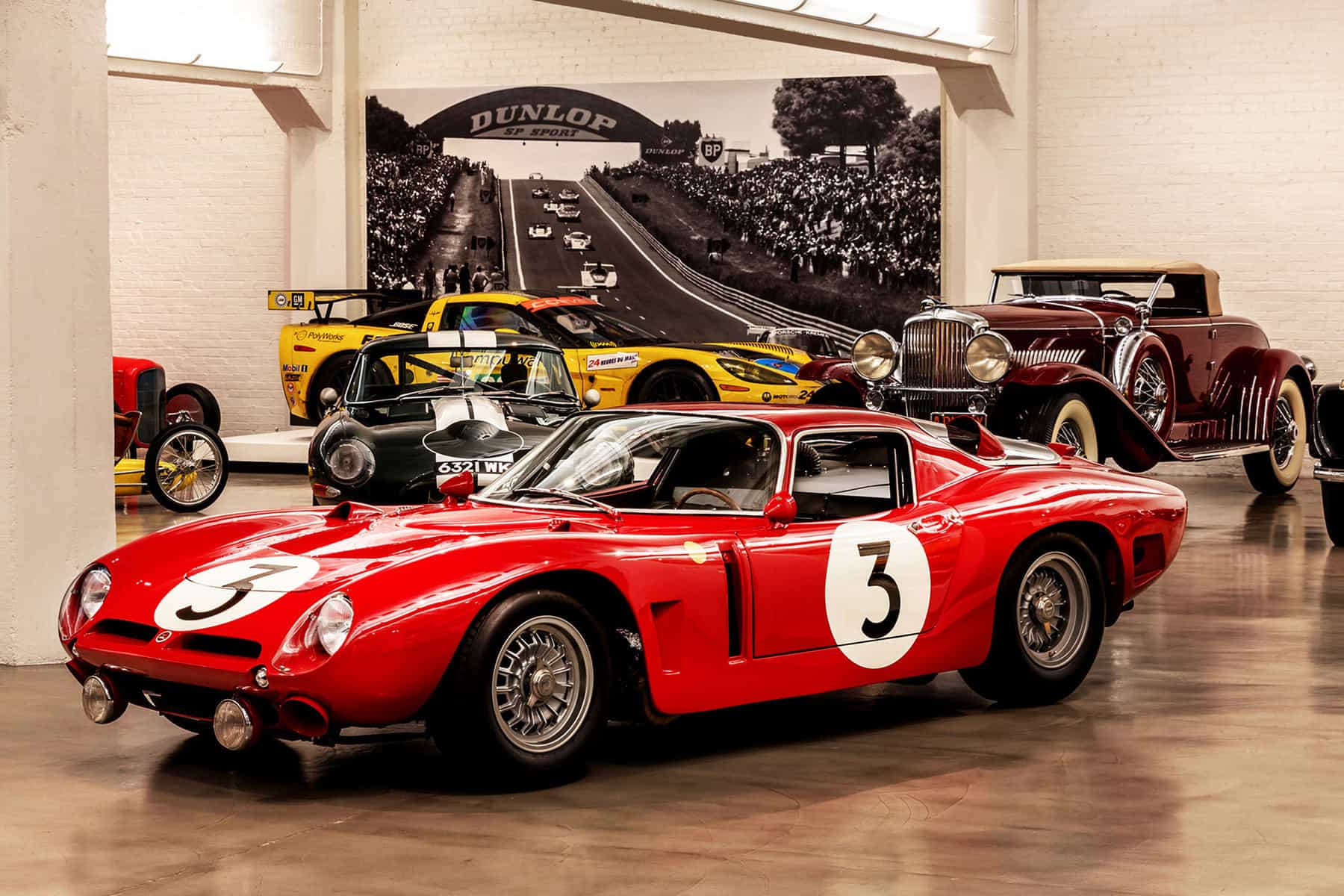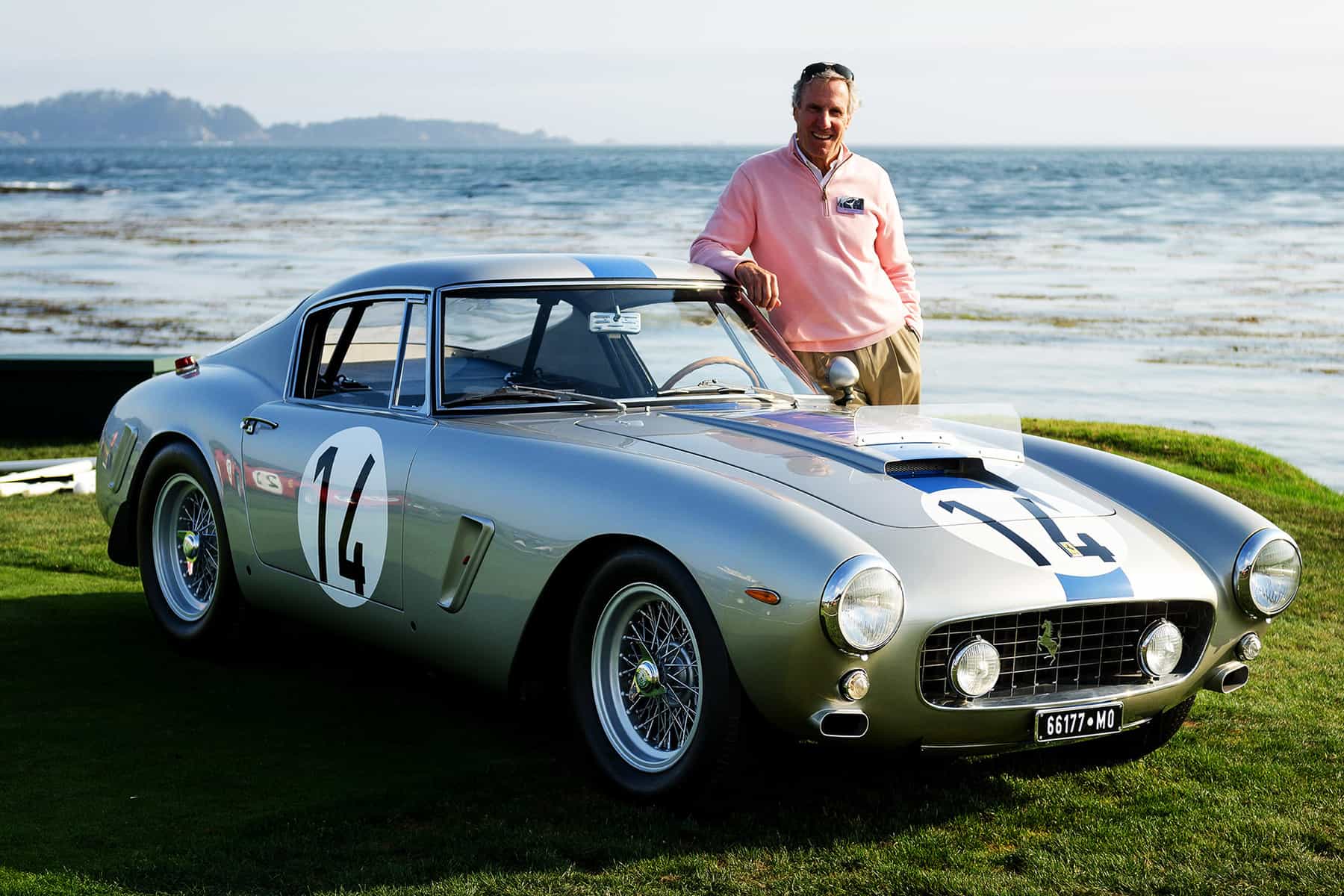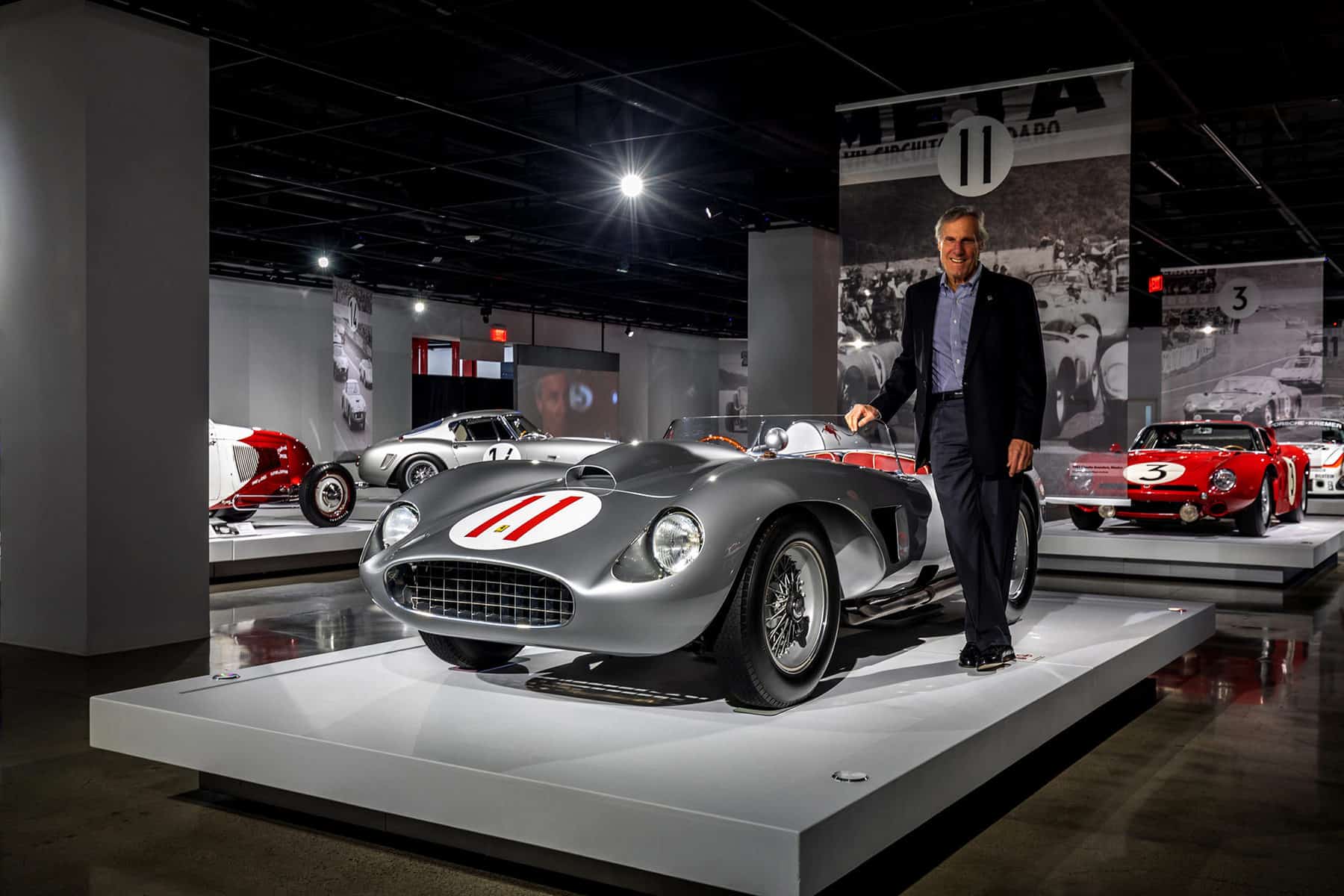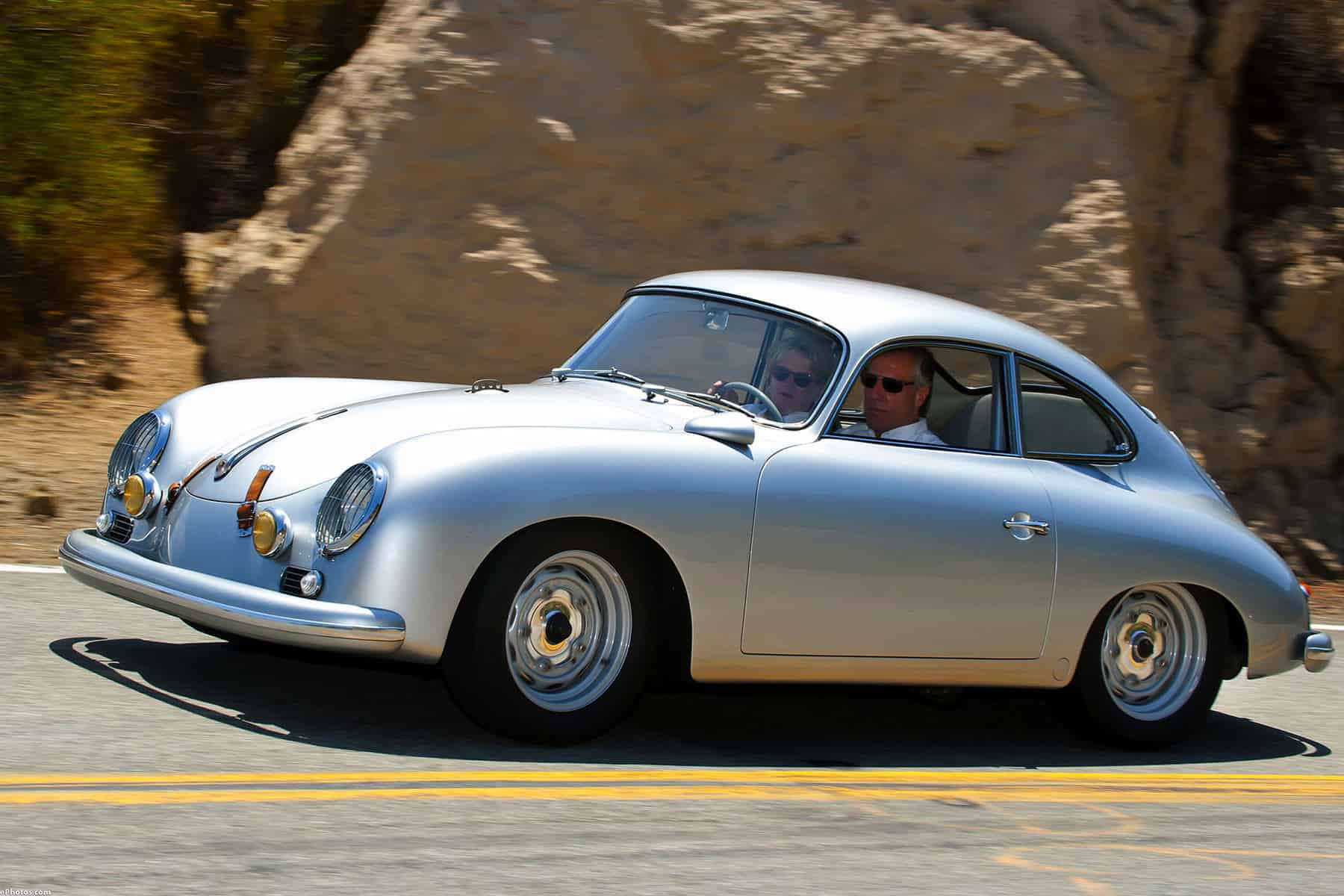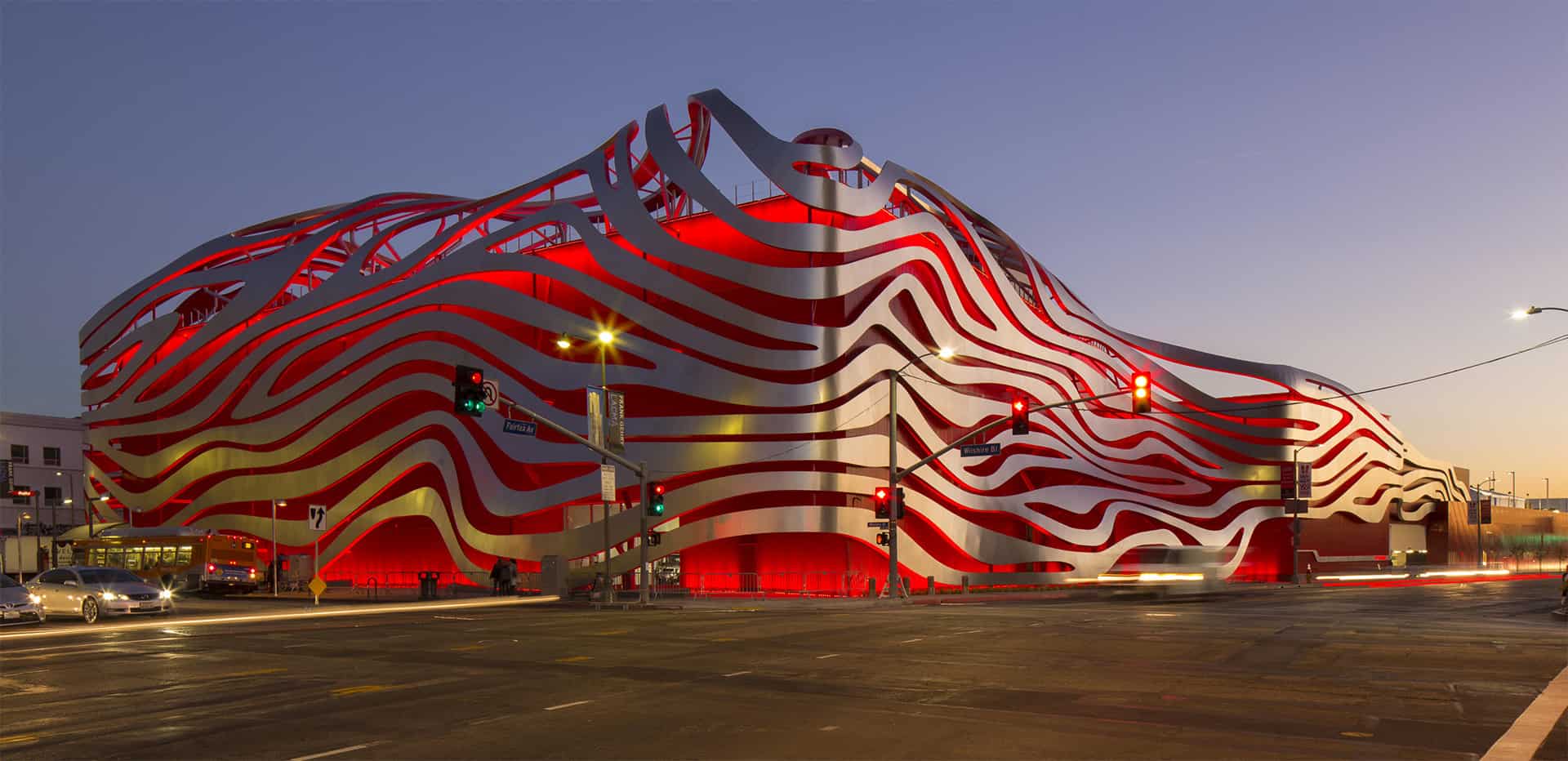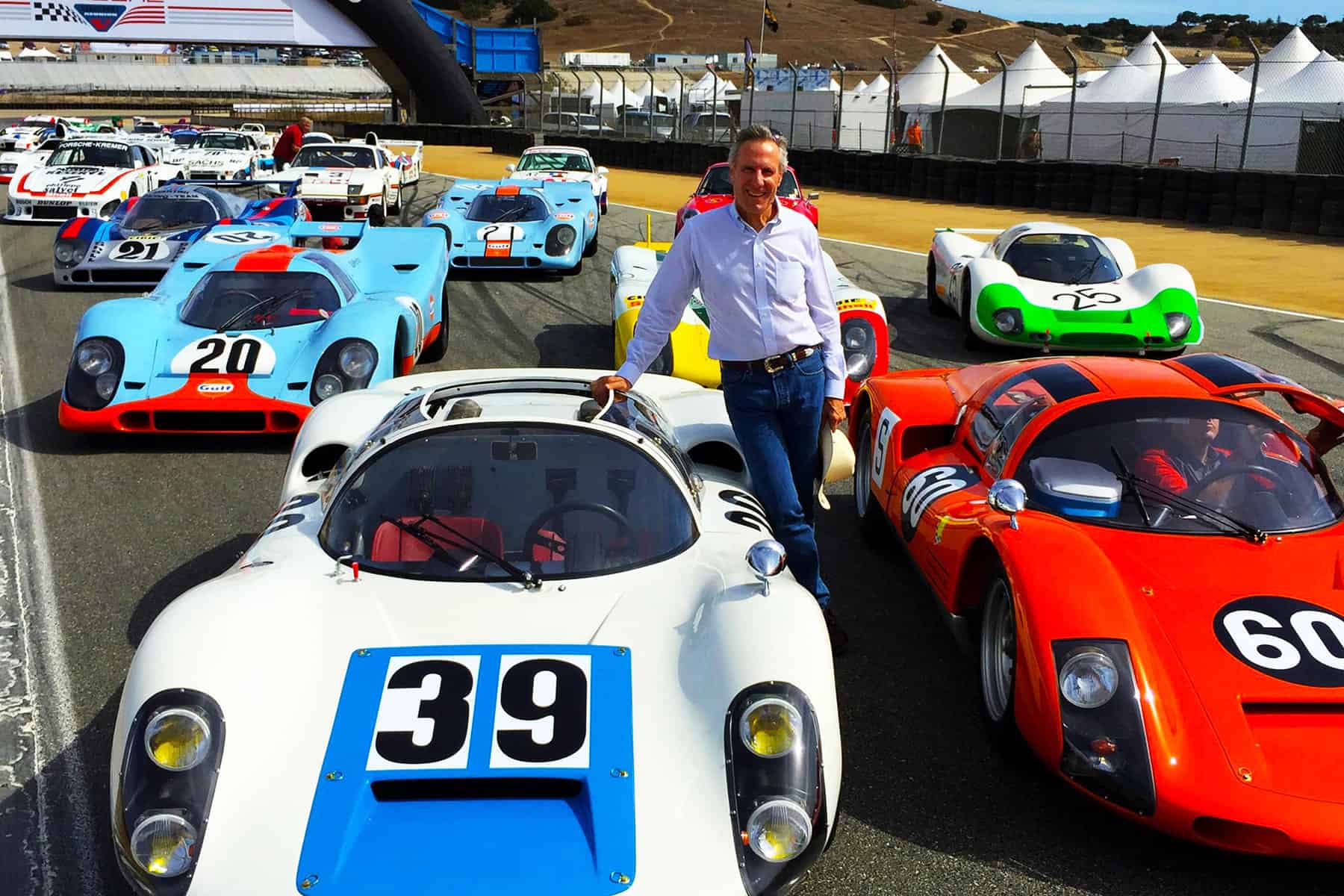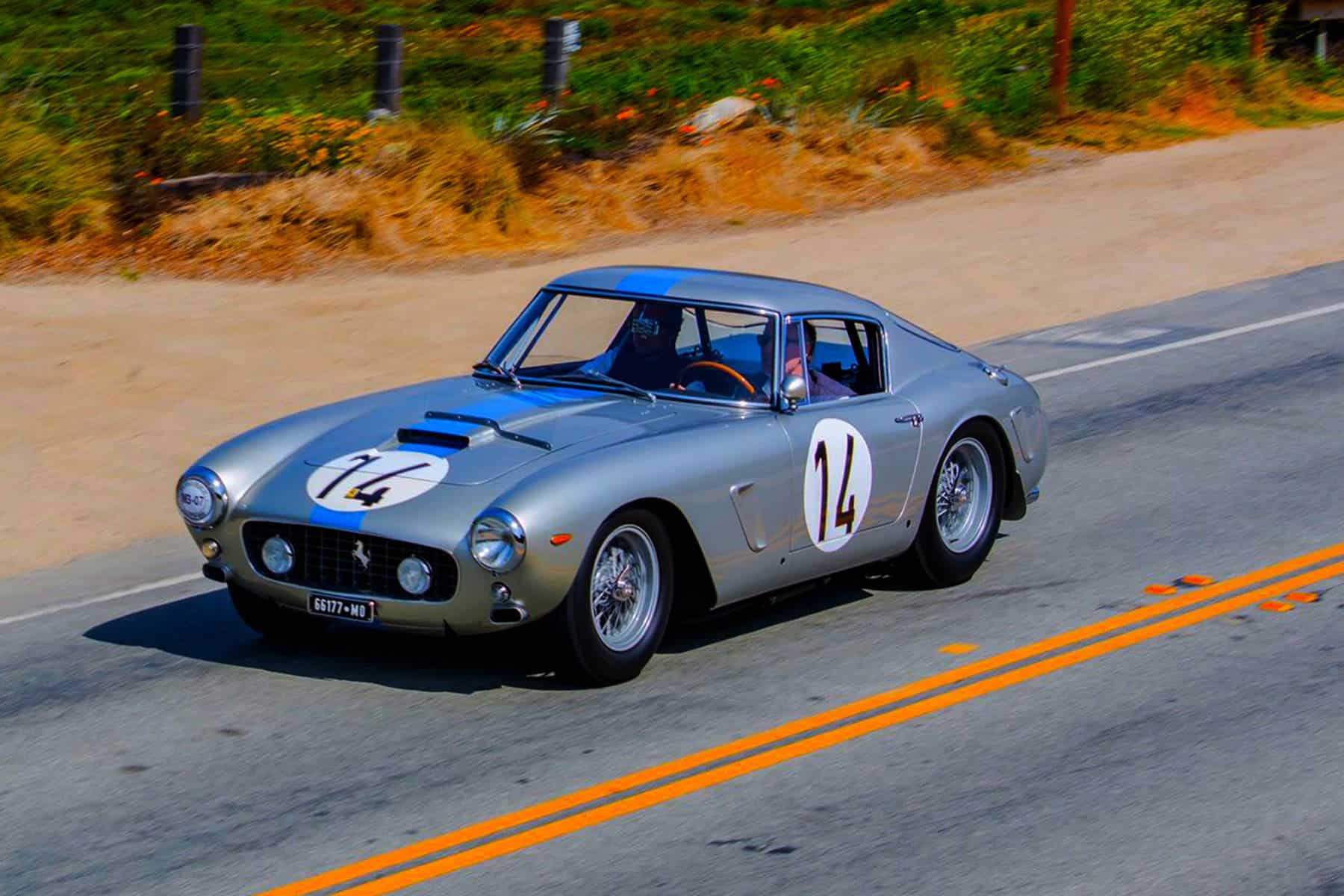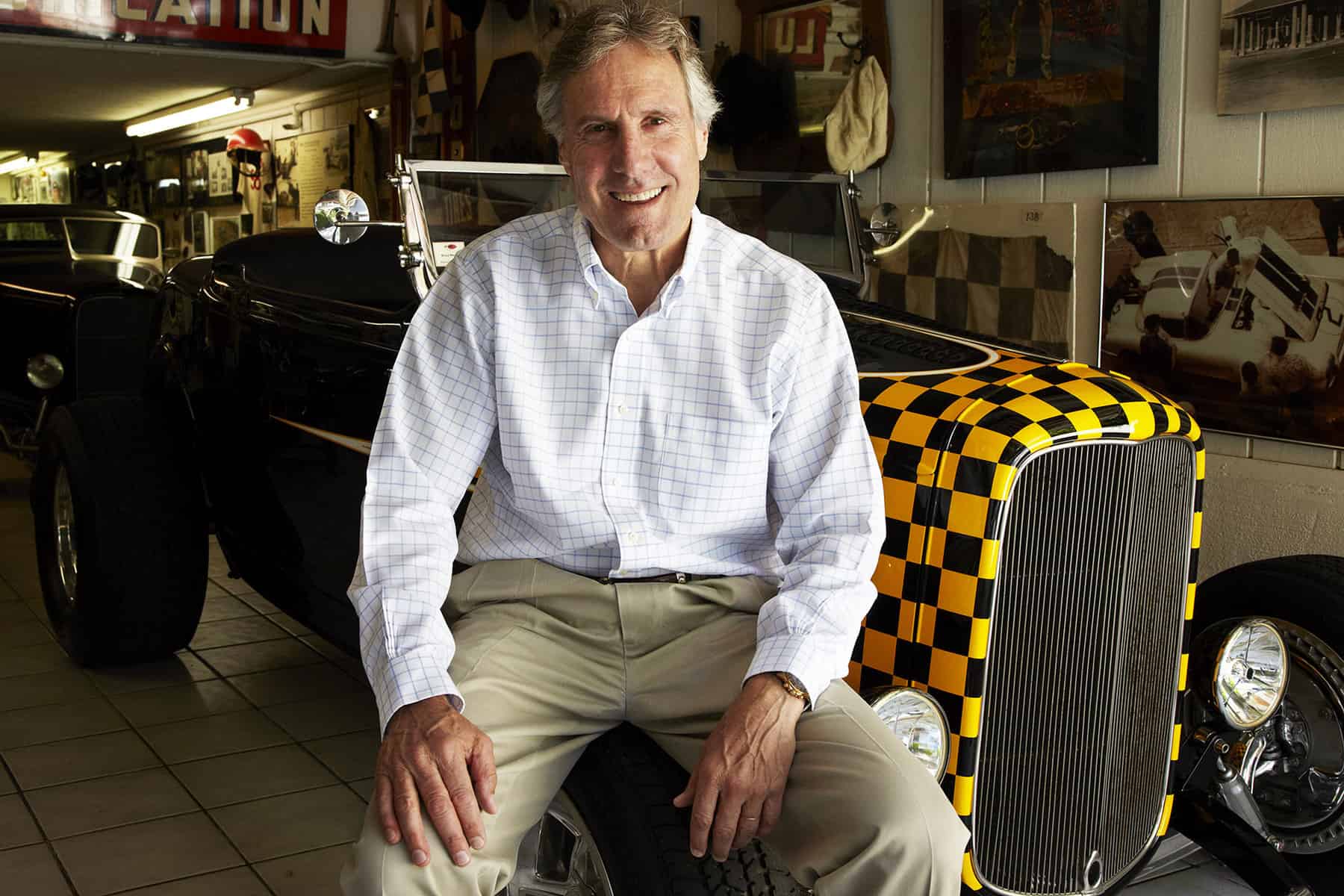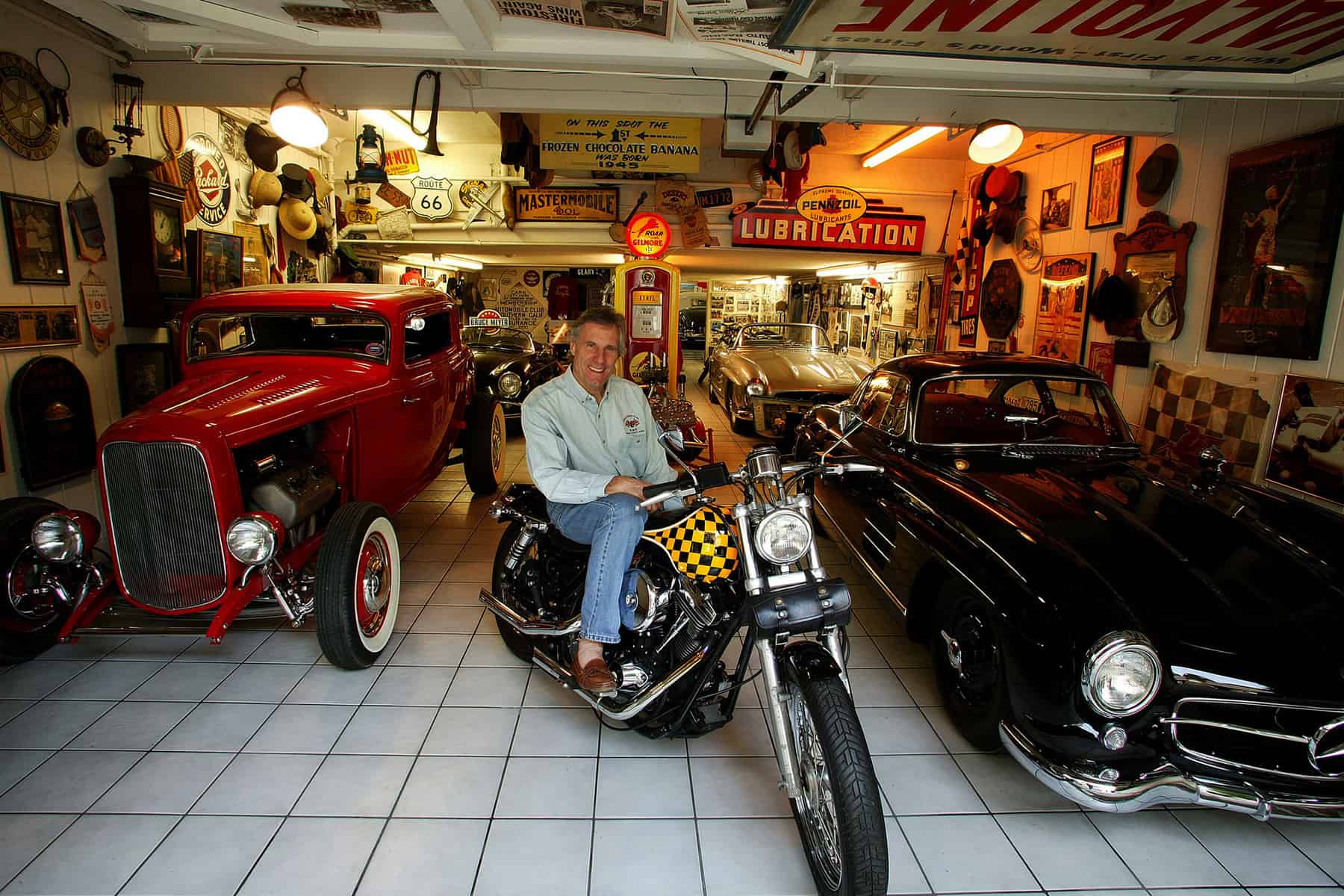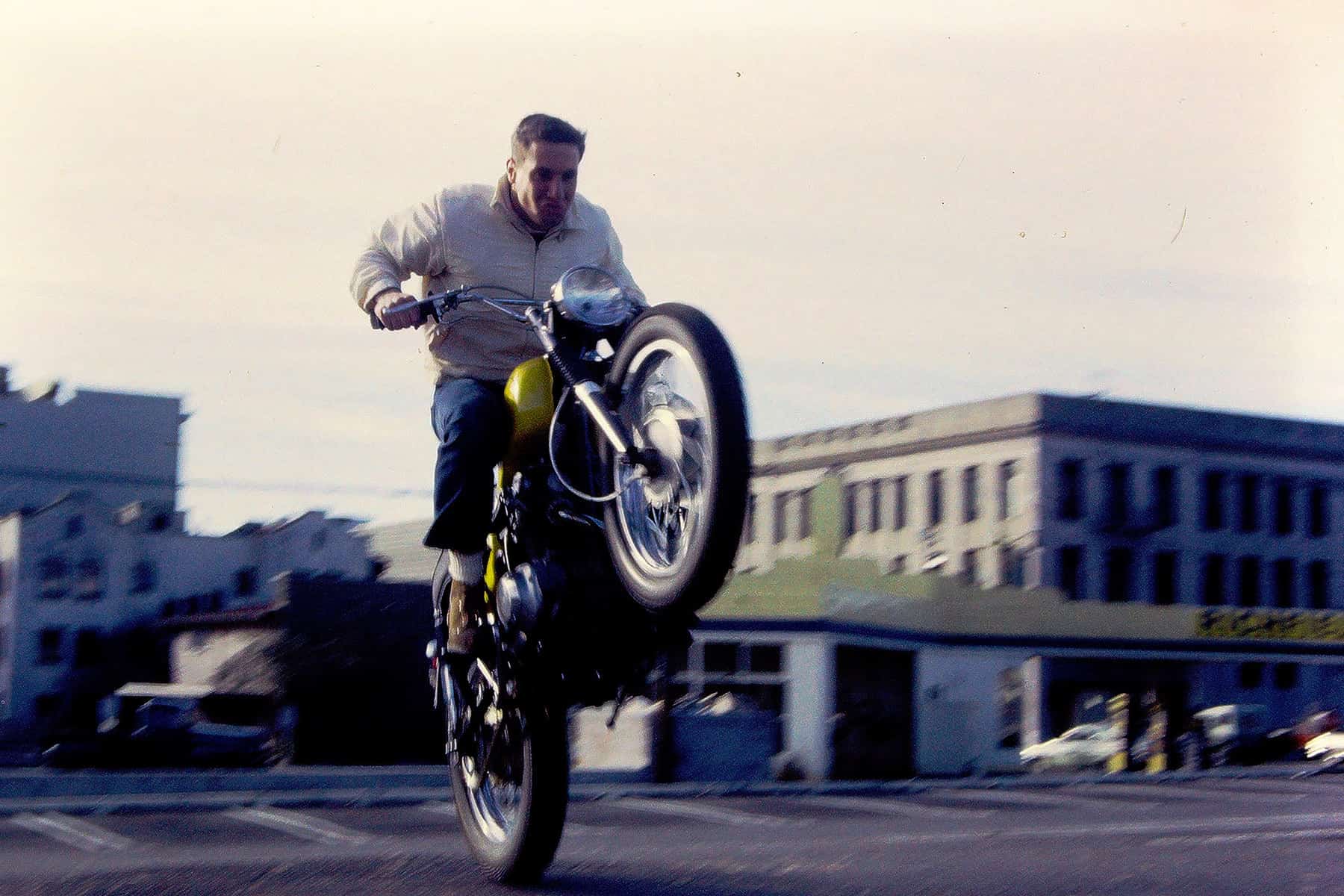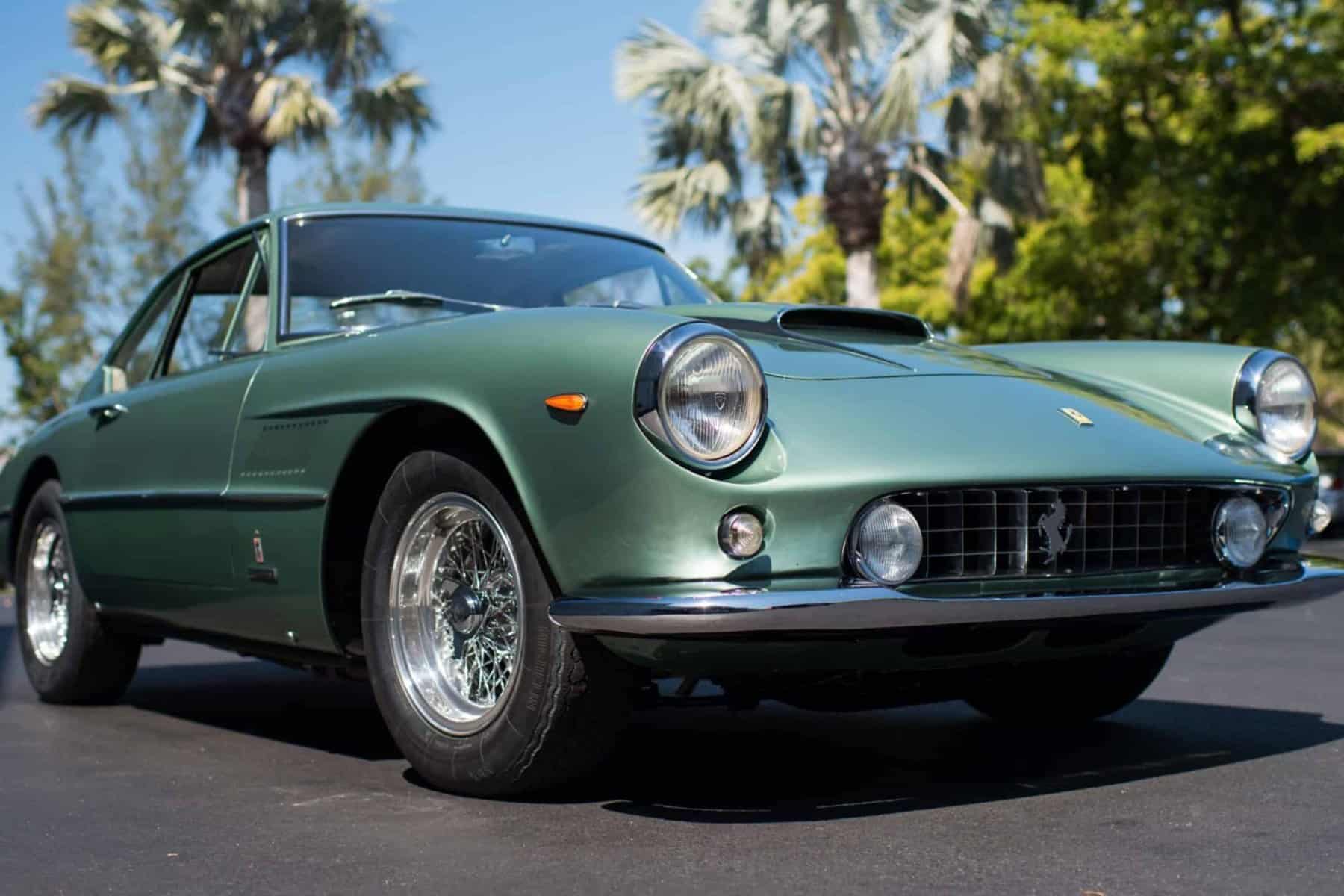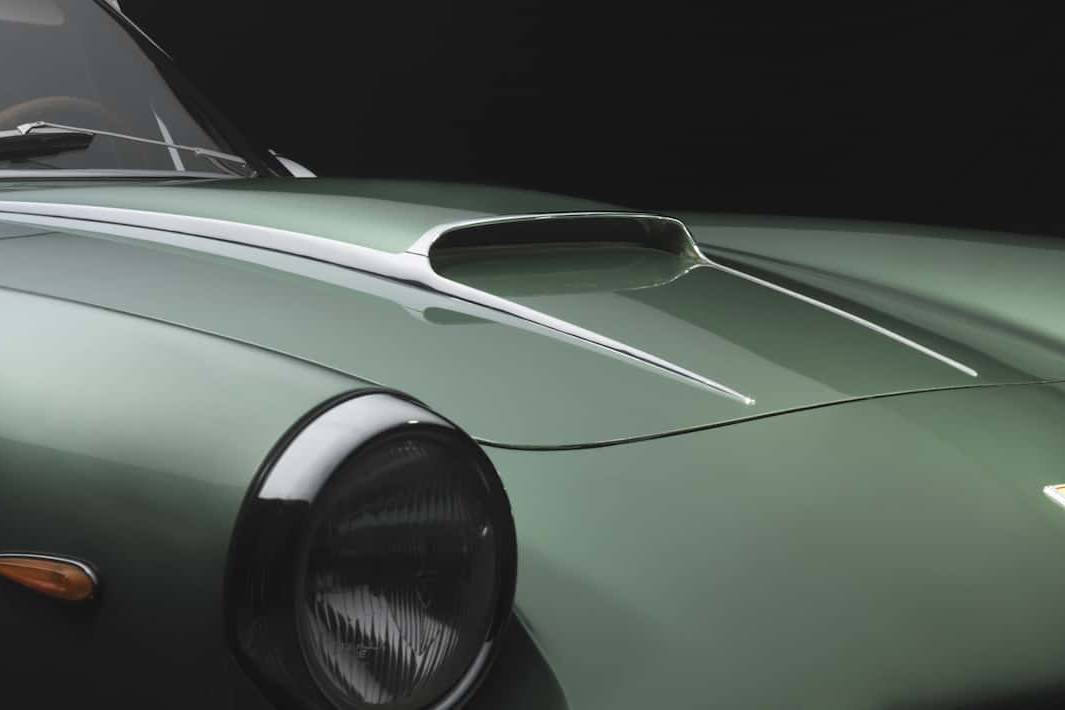“It’s All About People”
Talking with Bruce Meyer, quintessential car guy
BY: KEN GROSS
Bruce Meyer is the vintage car collector we’d all like to be. He only collects the best and he drives his cars everywhere.
He’s got everything from the classic Doane Spencer ’32 Ford (actually he has ten ’32 Fords!) to a Duesenberg J, along with record-setting, dry-lake race cars like the Pierson Brothers Coupe and the So-Cal Speed Shop Belly Tank, not to mention the Greer-Black-Prudhomme dragster, six Le Mans class winners, a pair of historic Ferraris, a Harry Miller-engined racing hydroplane, a hot-rodded Mercedes-Benz 300SL, an Outlaw Porsche 356A, a veritable wall rack of old motorcycles—including a BSA Gold Star and a Vincent Black Shadow—and much more.
They’re stashed away in a Beverly Hills loft, a primo space that’s the envy of commercial real estate developers. Bruce graciously spent some time with us to talk about his collection philosophy, his long involvement with LA’s Petersen Automotive Museum, his exploits at Bonneville, the car he wants most to own, and the one that got away…
“I’m not a collector, I’m an enthusiast,” Bruce likes to say. “Over the years, I’ve just bought cars that resonate with me, for some reason. But I do have a couple of focuses that are irresistible. One is my appreciation for early hot rodding, and how important that activity was to everything I love about cars. So, I did go out and research and purchase what I thought were important early hot rods.” (More about that in a moment.)
When he bought his Ferrari 250GT Short-Wheelbase Berlinetta, the 1961 Le Mans Grand Touring Class winner, and third overall finisher, driven by Pierre Noblet and Jean Guichet, Bruce began to focus on acquiring winning Le Mans 24 Hour race cars. “Suddenly, I just became intrigued with Le Mans,” he says.
“I think Le Mans is the most important motorsport race in the world,” Bruce explains. “More than Monaco, Indy, or any others in my eyes. It’s the Super Bowl and the World Cup of motorsports all in one. Nothing is more challenging than driving at top speed for twenty-four hours, basically on public roads.” He has since acquired one of Briggs Cunningham’s three Le Mans racing 1960 Corvettes; the 1965 Iso Bizzarrini A3/C competition coupe that won its class at the Sarthe Circuit in 1965; the class-winning 1967 Porsche 910 from the 1969 race; the 2008 Corvette C6.R, the GT Class winner from 2009; and arguably the pièce de résistance: a Porsche 935 Kremer M3, the 1979 overall Le Mans race-winning car. Bruce has been spotted driving this 217-mph speedster in Beverly Hills, as well as on the lawn at Amelia Island.
But unsurprisingly, Bruce goes one step further. After the cars are restored, he then reunites them with the drivers/builders who made them famous. The first was the Agajanian Special, an Offy-powered, open-wheel racer that won the 1952 Indy 500, driven by then-22-year-old Troy Ruttman. “I grew up with the Agajanians and I went back to Indy with them. So, when the Agajanian Special came up for sale, I just had to have it. And as soon as I got that car, I started thinking, I’ve got to get hold of Troy.” And he did, bringing Ruttman out of retirement for an unforgettable commemorative evening that brought tears to people’s eyes.
“That was a big deal for me,” says Bruce. “The car hobby is all about people. We think about the people first, not the cars. If somebody would’ve told me that I would get to know Parnelli Jones or Dan Gurney, I never thought of being worthy enough. It’s only through cars that that happened.”
In November 1992, after the Pierson Brothers’ ’34 Ford competition coupe restoration was completed, Bruce reunited the builders, Bob and Dick Pierson and Bobby Meeks, with a host of aging hot-rod luminaries, including Carroll Shelby, Bob Petersen, Pete Chapouris, Jim “Jake” Jacobs, Bob Petersen, Tom Sparks, Boyd Coddington, Lil’ John Butera, Alex Xydias, Ray Brown, Dick Kretz, and many others, for a special night at his garage. “There are over thirty people in that photo,” says Bruce, “and there are only nine left.”
He did the same thing with Bob McGee, whose legendary ’32 Ford roadster was featured on the cover of Hot Rod magazine in October 1948. “When we were ready to restore that car,” he says, “I called Bob McGee’s son to get some information, and he said, ‘Would you like to speak with my father?’ I had thought Bob had died. Next thing I knew we were talking, and Bob helped us with the restoration.” (That car is now a Historic Vehicle Association honoree and one of just two hot rods ever to be featured on a U.S. postage stamp.)
“As people get older,” Bruce continues, “it’s so easy to be forgotten. When I was growing up, two doors down from my grandmother lived a lady named Mrs. Bannon. She’d been famous, but when she got into her 90s, no one ever came to see her but me. I think old people just love it when they’re remembered. So, I have always taken a liking to old people and old heroes. I always have time for a World War II veteran.”
Bruce was particularly fond of Tom Sparks, an early bicycle racer turned famous hot rodder. A very talented mechanic who worked at first for Eddie Meyer, Sparks then had his own restoration shop and later worked with film industry luminaries like Francis Ford Coppola (on Tucker: The Man and his Dream.) “Tommy never got the credit he was due, so I just made a point to take him wherever I went. He was so worthy and so appreciative.” Bruce called in a favor with Dr. Ron Busuttil, a renowned surgeon and liver cancer specialist, who saved Sparks’ life. “Ron’s just retired,” Bruce notes. “So, I don’t want to have liver problems. Now that (Simeone Museum founder) Fred Simeone has retired, you don’t want to have brain cancer either.”
Meyer was instrumental in ensuring that the Petersen Automotive Museum, now the largest and most successful auto museum in the country, got off to a great start. From getting people enthusiastic and keeping Robert “Pete” Petersen motivated, to founding the Checkered Flag 200 support group, Bruce was all over it. It started in 1992. “Pete wasn’t a hardcore car guy,” Bruce says. “He was hardcore airplanes, and hunting, and guns and ammo, but he loved ‘the deal.’ If he could buy something on the cheap, he was in. A realtor brought him the old Seibu/Orbach’s department store building and Pete thought, ‘This would make a great car museum.’”
Earlier, Petersen had tried and failed with a car museum in Hollywood. Both Petersen and Meyer were on the Board of the Natural History Museum of Los Angeles (NHM) which had a car collection that included an ex-Earl Cooper Stutz “White Squadron” race car, Raymond Loewy’s customized BMW 507, a Duesenberg roadster, and much more – and none of it was on display. “So much of our culture in L.A. revolved around the automobile,” Bruce says. “So it was a natural. The NHM got Gray Line Tours on board and optimistically thought that combination would draw a million people a year. But there were no car guys involved and there was no passion.”
In 1993, Bruce thought he’d get two hundred guys to “pony up $1,000 a year and establish a museum support group. People told me, ‘you’re nuts, you’ll never get two hundred people.’ To make a long story short, I rounded up the right people, and we had great events in places you just couldn’t go. Now we have over six hundred members and it’s $1,700 per year, so you can do the math. People are proud to be CF200 members.”
Bruce continues, “But after twenty-five years, the Museum looked run down and it needed a change. David Sydorick (a museum supporter who has a fabulous Italian car collection in Beverly Hills), and I started with the idea of a facelift. It became a complete 100 percent redo. We literally took every nut, bolt, display sign, and oil can out of there, stripped the place and spent $113 million. We interviewed architects from Chris Bangle to Frank Gehry. We knew we had to achieve a significant new look to draw attention. Our architect, Gene Kohn from Kohn Pedersen Fox, had buildings all over the world and nothing in Southern California. He never asked for a dime until it was built. Gene told us, ‘if you build it, you can pay me, no problem.’ Frank Gehry had said, ‘Give me a million dollars and I’ll think about it.’
“We wanted something very different, extreme and attention-getting. And we got it. David and I orchestrated the whole deal and then realized ‘we’re going to have to lead this thing.’ I’d been chairman for ten years, so I said, ‘David it’s your turn,’ but he didn’t want to lead. That’s when we went to Peter Mullin. He’s a good executive, he held great meetings. He took us over the building hump, so to speak.”
The Petersen relaunched spectacularly with Peter Mullin’s Bugatti collection in the new main gallery and “Precious Metal,” an artistic arrangement of twelve superb silver cars, including a Ferrari Testa Rossa, a Pierce-Arrow Silver Arrow, and the “20 Grand” Duesenberg J upstairs. That exhibition was worthy of a fine art museum. Bruce explains how it came about. “The Resnicks built a building across the street from LACMA (the LA County Museum of Art). It was perfect for an automobile display. I went to Michael Govan (LACMA executive director), not long after the Guggenheim had done “The Art of the Motorcycle,” and I laid out the entire all-silver car presentation as an exhibit for them. He never did anything with it, so when we went to reopen, I proposed it to our group, and they loved the idea. It was one of those exhibits that just resonated with everyone.”
Bruce’s passion helped legitimize the classic American hot rod, culminating with historic hot rod classes at the Pebble Beach Concours d’Elegance. In the late 1980’s, Bruce almost inadvertently bought a little red ’32 Ford from Jim Busby that had been on the cover of Hot Rod magazine in May 1959. Originally full-fendered, with a fuel-injected small-block V-8, it had been modified for pinstriper Andy Southard by Dick (“Magoo”) Megugorac as a fenderless highboy with a milder Chevy engine. “It was the kind of car I’d have killed for when I was in high school,” Bruce admits.
“At first, my friends laughed at me,” he says, “but the more I drove it, the more I realized how much fun I’d not had when I was younger. Nobody doesn’t like a hot rod. Everybody gives you a thumbs-up. So, I started thinking there’s probably other cars out there that were significant, and I thought ‘I’ve got to do something for the old hot rodders.’”
Bruce was friends with hot-rod legends Tony Nancy, Ray Brown, Alex Xydias, Wally Parks, and John Wolf, and they often lunched together. “I thought, ‘these guys have all been forgotten.’ The whole Shelby Cobra effort was all done by hot rodders, from Phil Remington, Pete Brock, Dean Moon, and the Gammells, father and son. And I remembered Phil Hill telling me about his club, the Low Flyers, in Santa Monica, with Stuart Hilborn, Phil Remington, Howard Wilson, and Jack Engle. I thought, that story needs to be told. At that point, I don’t think there were many hot rods west of the Harbor Freeway. It was an unacceptable art form.
“So, I started working on Lorin Tryon (who was then in charge of classes for Pebble Beach), and I sent him every article about hot rods and racing people that I felt helped the cause. I did that for about ten years. J. Heumann, who worked with Lorin, had said, ‘Never! Over my dead body!’ But finally Lorin must have thought, ‘let’s throw Bruce a bone and see how it goes.’ The class was very popular – and it still is. People have sought out historic hot rods and restored them, just to bring them to Pebble.” (Full disclosure: In order for Bruce to be an entrant with his own hot rods, I’ve selected the cars and been the chief class judge for the historic hot-rod class since its inception in 1997. And if you’re wondering, Bruce hasn’t always won.)
Bruce established the respected Bruce Meyer Award at the Grand National Roadster Show, to be presented annually to the best historic hot-rod restoration. “That started at the Oakland Roadster Show, when I brought the Pierson Brothers’ Coupe up there, and Don Tognotti, the show promoter, asked if I would sponsor an award for preservation/restoration of a traditional car or even a new car that’s built in the spirit of old hot rods. The trophies by sculptor Steve Posson are very cool. I thought it would blow over after a year. When you get guys like Ross Myers, who has an incredible hot-rod collection, vying for this award, it’s really special.”
We had to ask, is there something he loves besides cars? “When I grew up,” Bruce replies, “work was everything. It took priority over family, over everything. Even to this day, my family jokes, because I like work more than play. Okay, I have a passion for the 11-99 Foundation, I was on the founding board of that organization (they raise funds for widows and orphans of fallen CHP officers), and I’m involved with the Children’s and St. John’s Hospitals, so I do my civic duty. But if there’s anything that I enjoy more than cars, it’s real estate.
“I can do it with my son Evan so it’s almost like a hobby. In fact, I consider myself a real estate hobbyist because I’m not a classically trained real estate guy. I don’t leverage properties. I don’t even look at the capitalization rate. People buy real estate on a cap rate, the ratio of net operating income to property asset value. That’s the traditional way people buy, sell, and manage real estate. That’s not how I buy. A couple of friends in the business said ‘we want to do some projects with you.’ We have six buildings together. I found all of them, and I have no idea what the cap rate is – but I’ll just see a building and I’ll say ‘let’s buy that.’ I just tell them my vision, and we’ve done really well with that.”
He goes on, “My approach to real estate is much the same as my approach to cars. I don’t look to see what a car is worth that very minute, but I do try to buy totally unique, artful things that can’t be replicated. I go for the aesthetic. If it’s a good-looking building and I can visualize it, then I buy it. I don’t get all tangled up in the bottom line. I ran Geary’s (his family’s posh gift store in Beverly Hills) the same way. My dad was a product of the Depression, and every single penny had to be accounted for. He loved to buy close-outs and see how he could maximize it. I went in and bought the coolest-looking stuff I could find, and if we made money at the end of the year, so be it. I guess we did it right.”
He continues, “I’ve always been passionately driven. I love old cars, but it could be the most famous hot rod in the world and, if I don’t like the look of it, I have no interest. I’m completely visual, both in my business, in real estate, and in my cars. I love real estate as much as I ever have. I just don’t approach it the way most real estate guys do.”
Back to cars, Bruce is a member of the coveted 200 MPH Club at Bonneville. “You can’t overlook the importance of the dry lakes and Bonneville in hot rodding,” Bruce insists. “It is lunar, it’s the most magical place, like none other on earth. Just the name Bonneville is special. From Reid Railton to John Cobb, everything rotates around Bonneville. It was always on my bucket list. I was just enamored of it, but I didn’t realize how hard it was to do. My friend Jack Rogers asked if I wanted to drive his Camaro. First you have to be licensed at various levels. You can be Parnelli Jones, but you can’t compete there without a license. I licensed myself at the required speed levels in Jack’s car, and then I looked at Bonneville like you’d look at the rodeo. Everybody goes to see the bull riders. You watch the barrel racers and the calf ropers, but the bull riders are the thing. At Bonneville, it’s the roadsters. I thought it would really be cool to drive a roadster.
“I bought the Pierson Brothers coupe from Tom Bryant, right when it was cooling off after a 200-mph run. When you get something that goes straight down the road, you just keep adding power and adding power and going faster. At Bonneville, everything gets recycled. I found this ’32 Ford roadster that had done well, but it was old tech, it had a wet sump engine, no air shifter and it needed to be brought up to date. I had Mike Cook, the big Bonneville guy, rebuild it. I’ll tell you, that drive, that five miles flat out, is unlike any other motoring experience ever. And getting in the 200 MPH Club was wonderful. I was just in tears. There are guys who spend their whole lives trying to get in it. It’s a pretty exclusive group. These Bonneville guys play hard. It’s not easy, and it was a really big thing for me.”
Bruce really doesn’t need to buy another car, but we had to ask what else he wanted. If somebody said, magically, you could have one more car, what would it be? “It’s a very easy decision for me,” Bruce says without hesitation. “It’d be a Scarab. The Scarab was built by hot rodders. It walked the walk; it’s as pretty as anything that ever was. It’s got a great story. The good news is there’s only three of them. Miles Collier, John Mozart, and Rob Walton are the owners. I can’t change anyone’s lifestyle, by buying their Scarab – and they’re not for sale, anyway. It’s an epic car.”
But there is a Scarab clone, built by the late Don Orosco, using some original Scarab parts. Bruce says he’s been tempted, but he knows “it’s just not okay” to buy a replica – so that wish may not ever be granted.
And the one that got away?
Many years ago, Bruce was looking for Stuart Hilborn’s 150-mph record-setting lakester, the Hot Rod magazine cover car from April 1948. Back when I was the director of the Petersen Museum, Bob (Pete) Petersen and I were looking at old Hot Rod covers. Pete said, “I shot that photo of Stuart in his car. Where’s that car now?” I told him Bruce was advertising in Rod & Custom and Hemmings to try to find it. Pete looked hard at me and said, “Well, you’d better find it before Bruce does.”
“When COVID-19 came back in March,” Bruce says, “I started going through old files in my desk and I came across a whole file I’d put together. I ran ads everywhere trying to locate that car, and I never was able to find it.”
He continues, “I found a letter in that file from a guy in Oklahoma. He wrote, ‘I’ve got the car and it’s not going anywhere. You’re never gonna own it.’ It was mean-spirited. Stu Hilborn was still alive, and I thought it’d be a great thing. I followed the car to a junkyard. I did everything I could to find it. I don’t think it still exists.”
If anyone reading this knows where the ex-Stuart Hilborn lakester is today, Bruce Meyer would love to talk with you.
Photos courtesy of Bruce Meyer.
